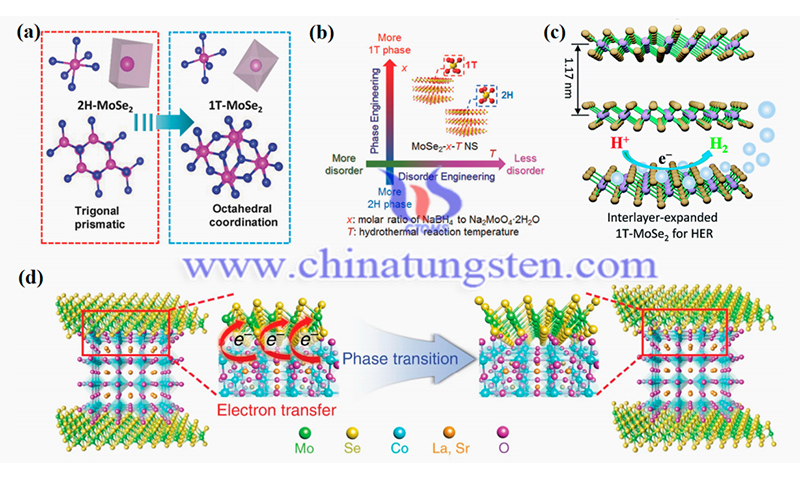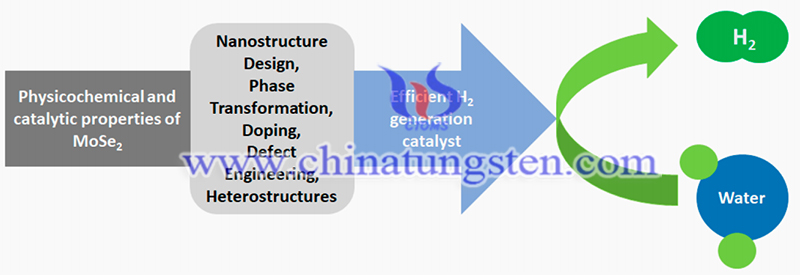2D Molybdenum Diselenide and Its Hybrids for Hydrogen Generation Applications
- Details
- Category: Tungsten Information
- Published on Tuesday, 21 June 2022 14:24
Hydrogen (H2) is a green and economical alternative to conventional fossil fuels due to its zero carbon emission. 2D molybdenum diselenide (MoSe2) hosts significant applications in hydrogen generation due to its low hydrogen adsorption Gibbs free energy and good electrical conductivity. The development of efficient hydrogen evolution reaction (HER) catalysts is of great interest for economical green hydrogen production.
Two-dimensional transition metal dichalcogenides (TMDCs) are considered excellent alternatives to noble metal hydrogen generation catalysts. Among other TMDCs, two-dimensional MoSe2 is favored due to its lower hydrogen adsorption Gibbs free energy, good electrical conductivity, and higher metallicity. Moreover, the physicochemical and electronic properties of MoSe2 can be easily tailored to suit HER applications through a simple synthesis strategy.

(Credit: Muhammad B. Wazir/ACS Omega)
Herein, a recent study published in ACS Omega 2022, 7, 16856-16865 reviews the application of two-dimensional MoSe2 in electrocatalytic HER, focusing on recent advances in modulating MoSe2 properties through nanostructure design, phase transformation, defect engineering, doping, and formation of heterostructures. The article also discusses the role of two-dimensional MoSe2 as a co-catalyst in photocatalytic HER.
The study titled “Review on 2D Molybdenum Diselenide (MoSe2) and Its Hybrids for Green Hydrogen (H2) Generation Applications” has been published in ACS Omega 2022, 7, 16856−16865. The study was carried out by Muhammad B. Wazir, Muhammad Daud, Soma Safeer, Faisal Almarzooqi, and Ahsanulhaq Qurashi.
MoSe2 has a two-dimensional lattice structure like MoS2, where the monolayer nanostructure is composed of a layer of Mo atoms sandwiched between two layers of Se atoms. The several-layer structure is formed by weak van der Waals interlayer interactions between several monolayers. MoSe2 can exist as a semiconducting 2H phase with a trigonal geometry or as a metallic 1T phase with octahedral geometry. Since Se is more metallic than S, MoSe2 exhibits higher electrical conductivity than MoS2. However, the metallic 1T phase is thermodynamically unstable and can be easily converted to the 2H phase.
The relatively low electrical conductivity, inactive substrate surface, and aggregation of nanosheets during the synthesis of MoSe2 limit its application. Fortunately, the physicochemical and electronic properties of MoSe2 can be easily tailored to suit HER needs with simple techniques. By increasing the number of active sites, improving conductivity, stability, and enhancing morphology, the researchers have fully exposed the active sites of 2D MoSe2 thereby effectively improving HER performance.

(Credit: Muhammad B. Wazir/ACS Omega)
The 2H→1T phase transition of 2D MoSe2 enhances the electrical conductivity and activates the substrate surface, thus improving the performance of hydrogen generation. Nanostructure design is also an important tool to fully utilize the superior HER potential of 2D MoSe2. The formation of nanosheets and nanosheets with enhanced morphology and exposed active sites can improve the overall performance.
In addition, carbonaceous materials can also be activated by nitrogen doping for HER. however, the synthesis of MoSe2 with lattice-like structures is still challenging. In addition, green synthesis of MoSe2-based catalysts should be pursued so that the generation of hydrogen is fully compliant with green standards.
In conclusion, MoSe2 also acts as a good co-catalyst in photocatalysis and photocatalytic HER. The activity of 2D molybdenum diselenide as an electron exporter in photocatalytic H2 generation can be further enhanced by phase transformation, defect engineering, doping, and other techniques used for electrocatalytic HER. In addition, the construction and experimental investigation of direct scheme photocatalysts for MoSe2 is a new avenue of exploration that may yield better results in terms of overall water splitting.
| Molybdenum Supplier: Chinatungsten Online www.molybdenum.com.cn | Tel.: 86 592 5129696; Fax: 86 592 5129797;Email:sales@chinatungsten.com |
| Tungsten News & Prices, 3G Version: http://3g.chinatungsten.com | Molybdenum News & Molybdenum Price: http://news.molybdenum.com.cn |



 sales@chinatungsten.com
sales@chinatungsten.com